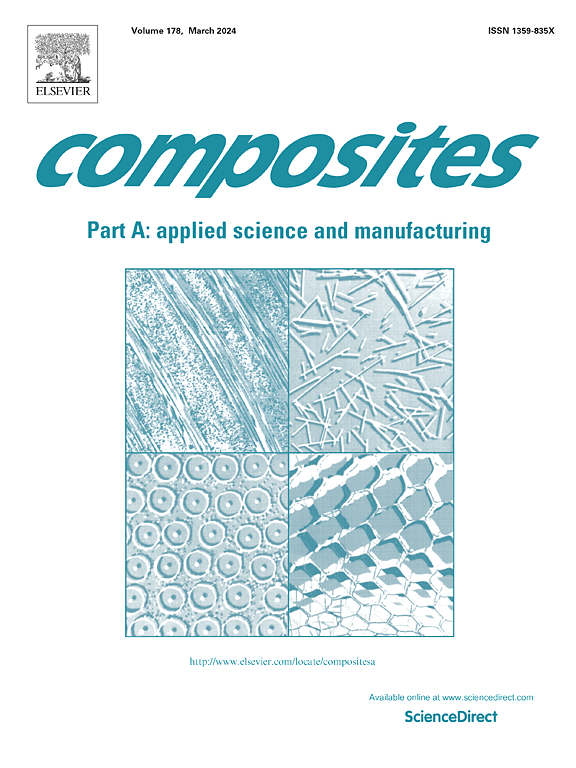Multifunctional bioactive glass fiber reinforced composite scaffolds: A “four-in-one” approach for adjuvant therapy in tumor-derived bone defects
IF 8.1
2区 材料科学
Q1 ENGINEERING, MANUFACTURING
Composites Part A: Applied Science and Manufacturing
Pub Date : 2025-04-25
DOI:10.1016/j.compositesa.2025.108987
引用次数: 0
Abstract
After bone tumor resection, preventing recurrence and reconstructing bone defects pose significant challenges. Conventional adjuvant therapies, including chemotherapy and radiotherapy, may prevent tumor recurrence but come with substantial side effects and do not contribute to bone repair. Herein, multifunctional composite scaffolds, modified with phosphate glass fiber (PGF), were prepared using 3D printing for photothermal tumor eradication and bone regeneration. These composite scaffolds exhibited excellent photothermal performance and could effectively kill tumor cells. The photothermal performance was derived from the integration of PGF and could be controlled by PGF content and laser power density. PGF acted as reinforcement and enhanced the mechanical properties of these scaffolds. Furthermore, the scaffolds degraded gradually, accompanied by the release of bioactive ions, promoting the proliferation of bone cells. Overall, these multifunctional composite scaffolds achieved a “four-in-one” function of photothermal anti-tumor, bone repair promotion, spontaneous degradation, and mechanical support, advancing implanted biomaterials for tumor-derived bone defects.
多功能生物活性玻璃纤维增强复合材料支架:肿瘤源性骨缺损辅助治疗的“四位一体”方法
骨肿瘤切除后,预防复发和骨缺损的重建是一个重大挑战。传统的辅助治疗,包括化疗和放疗,可以防止肿瘤复发,但有很大的副作用,并不能促进骨修复。本文采用3D打印技术制备了磷酸盐玻璃纤维(PGF)改性的多功能复合支架,用于光热肿瘤根除和骨再生。这些复合支架具有良好的光热性能,能有效杀伤肿瘤细胞。光热性能来源于PGF的积分,可由PGF含量和激光功率密度控制。PGF作为增强剂,增强了支架的力学性能。此外,支架逐渐降解,伴随着生物活性离子的释放,促进骨细胞的增殖。综上所述,这些多功能复合支架实现了光热抗肿瘤、促进骨修复、自发降解和机械支持“四位一体”的功能,推动了肿瘤源性骨缺损植入生物材料的发展。
本文章由计算机程序翻译,如有差异,请以英文原文为准。
求助全文
约1分钟内获得全文
求助全文
来源期刊

Composites Part A: Applied Science and Manufacturing
工程技术-材料科学:复合
CiteScore
15.20
自引率
5.70%
发文量
492
审稿时长
30 days
期刊介绍:
Composites Part A: Applied Science and Manufacturing is a comprehensive journal that publishes original research papers, review articles, case studies, short communications, and letters covering various aspects of composite materials science and technology. This includes fibrous and particulate reinforcements in polymeric, metallic, and ceramic matrices, as well as 'natural' composites like wood and biological materials. The journal addresses topics such as properties, design, and manufacture of reinforcing fibers and particles, novel architectures and concepts, multifunctional composites, advancements in fabrication and processing, manufacturing science, process modeling, experimental mechanics, microstructural characterization, interfaces, prediction and measurement of mechanical, physical, and chemical behavior, and performance in service. Additionally, articles on economic and commercial aspects, design, and case studies are welcomed. All submissions undergo rigorous peer review to ensure they contribute significantly and innovatively, maintaining high standards for content and presentation. The editorial team aims to expedite the review process for prompt publication.
 求助内容:
求助内容: 应助结果提醒方式:
应助结果提醒方式:


